AnsaldoBreda T-68
| Ansaldo Firema T-68/T-68A | |
|---|---|
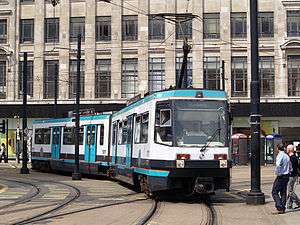 T-68 1011 in Manchester city centre in July 2008 | |
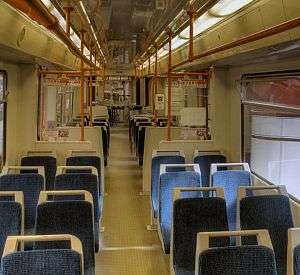 Interior of the prototype T-68 | |
| In service | 1992–2014 |
| Manufacturer | AnsaldoBreda |
| Built at | Naples, Italy |
| Family name | Firema |
| Constructed |
T-68: 1991–1992 T-68A: 1999 |
| Refurbishment |
2007–2010 midlife refurbishment, T-68 gain retractable couplers and covered bogies 2010–2012 reliability modifications, LCD screens, LED lights, driver's cab air conditioning |
| Number built |
T-68: 26 T-68A: 6 |
| Number in service | 0 |
| Number preserved | 6 |
| Formation | 2 carriages |
| Fleet numbers |
T-68: 1001-1026 T-68A: 2001-2006 |
| Capacity | 82/4 seats, 122 standing per vehicle |
| Operator(s) | Metrolink |
| Line(s) served | Altrincham, Bury, Eccles |
| Specifications | |
| Car body construction | Steel[1] |
| Car length | 29 m (95 ft 2 in) |
| Width | 2.65 m (8 ft 8 in) |
| Height | 3.7 m (12 ft 2 in) |
| Articulated sections | 2 |
| Maximum speed | 50 mph (80 km/h) |
| Weight | 49 tonnes (48 long tons; 54 short tons) per vehicle.[1] |
| Traction motors |
T-68: 4x 105 kW (141 hp) separately excited DC motors T-68A: 4x 120 kW (160 hp) three–phase AC motors |
| Electric system(s) | 750 V DC OHLE |
| Current collection method |
Pantograph Type: Brecknell Willis high reach |
| Track gauge | 1,435 mm (4 ft 8 1⁄2 in) standard gauge |
| Part of a series of articles on |
| Metrolink |
|---|
The T-68 is a model of light rail passenger vehicle that operated on the Manchester Metrolink network in England between 1992 and 2014. It was part of the Firema range of vehicles, built specifically as a high-floor, articulated bi-directional tram to operate solely on the Manchester Metrolink system. The T-68s were constructed by the Italian manufacturer AnsaldoBreda at their factory in Naples Italy, entering service in 1992.[2]
Six modified variants of the T-68 (known as the T-68A) were added in 1999. In July 2012 it was announced by Transport for Greater Manchester that all T-68 and T-68A vehicles would be replaced by M5000s by 2014. The last T-68 was withdrawn on 26 May 2014.[3]
T-68
The first T-68s entered service on 6 April 1992. Initially 26 (1001-1026) were ordered. Because low-floor tram technology was in its infancy at the time Metrolink was in its planning stages, and in order to be compatible with standard high-floor heavy railway platforms, inherited by Metrolink; the vehicles are high-floor, using the same 900mm platform height as main line trains.[4][2][1] In the beginning, several stops in the city centre (High Street, Market Street, Mosley Street and St Peter's Square) had dual height platforms, with one high part and one lower part, because of this, the T-68's were equipped with retractable steps to allow passengers to use the lower section of the platform. The dual height platforms have since been either rebuilt as high level platforms or removed. The T-68's could operate either as single units, or coupled together in pairs.[2][1]
The fleet later received various modifications, including electronic destination displays instead of destination blinds, retractable couplers, covered bogies, internal electronic displays, CCTV in place of mirrors and several other electronic modifications. 15 of the trams were later fitted with air conditioning units.[5]
Vehicle 1007 had non standard seating with higher backs and more rounded grab handles. The tram was named East Lancashire Railway at a ceremony at Bury Interchange by Pete Waterman on 31 May 2009. The final three T-68s were withdrawn on 10 February 2014.[6] Another vehicle 1003 was later given the new Metrolink livery.
T-68A
The six T-68As were introduced in 1999 for use on the Eccles Line, numbered 2001–2006. They were similar to the original fleet, but built with modifications to allow for a high proportion of street running on the Eccles line with other traffic. These included retractable couplers and covered bogies, as well as electronic destination displays instead of destination blinds. Three of the original fleet (1005, 1010 and 1015) also received the same modifications to allow them to run alongside the new T-68As. Later all bar 1018 - 1020 were similarly modified.[5] Originally the T-68A's were only authorised to run between Eccles, Piccadilly and the Queens Road Depot, but from 2009 they were modified to allow universal running on all lines. The T-68A trams only ever operated as single units.[1]
Vehicle 2001 was stored for several years as it developed a fault with the emergency brakes applying regularly without instruction to do so. The vehicle was completely rewired and brought back into service during 2011. The final two T-68As 2001 and 2003 were withdrawn on 30 April 2014.[6]
Livery
The trams were originally liveried in white, with a grey skirt, and a turquoise strip running along the skirt. Later modifications of this livery included the doors also being painted turquoise, and a turquoise strip painted along the top of the body, with thin orange or yellow lines separating the turquoise stripes and the white body.[2]
Names
Twenty-three of the T-68s at some point had name plates, named after famous Mancunian people, achievements, places or company sponsorship.
- 1000 The Larry Sullivan (Prototype)[7]
- 1003 "Once Upon a Wartime" - Imperial War Museum North[8]
- 1004 Vans. The Original since 1966
- 1006 Vans. The Original since 1966
- 1007 East Lancashire Railway
- 1014 Vans. The Original since 1966
- 1020 Lancashire Fusilier
- 1022 The Poppy Appeal
- 1026 The Power
Withdrawal
In 2008, the entire T-68/A fleet underwent a refurbishment programme, which was designed to keep them in service for at least another ten years.[4] However, the newer M5000 trams introduced from 2009 proved to be considerably more reliable than the T-68/A fleet; which averaged 5,000 miles between breakdowns, while the newer trams at introduction averaged 20,000 miles. The newer trams are also 10 tonnes lighter than the T-68/A's, causing less track wear, and using less energy. In July 2012, Transport for Greater Manchester announced all of the T-68/T-68As would be withdrawn and replaced with M5000s.[9][10] The final three T68s were withdrawn on 10 February 2014 and the last two T-68As on 30 April 2014.[6]
To farewell the T-68s, on 26 May 2014 a farewell tour was operated by 1007 and 1016, the former being the first tram to run on the system when opened in 1992.[11]
Preservation and further use
One T-68 (No. 1007) has been preserved at the Heaton Park Tramway, this tram was chosen for preservation as it was the first tram to run through Manchester City Centre on the system's opening on 27 April 1992.[5][12] Another (No. 1003) has been purchased as a training rig by Greater Manchester Fire and Rescue Service.[13] Four (1016, 1022, 1024 & 1026) have been transferred to the tram test centre at Long Marston.[14][15]
A single car prototype bodyshell numbered 1000 was built in Italy in 1990 and delivered to Manchester for public exhibition to promote the system. It is now preserved and displayed at the Museum of Transport, Greater Manchester.[16][17]
Gallery
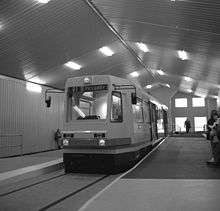 Pre-production bodyshell mock-up, on display to the public in 1990. Now displayed at the Museum of Transport, Greater Manchester.
Pre-production bodyshell mock-up, on display to the public in 1990. Now displayed at the Museum of Transport, Greater Manchester.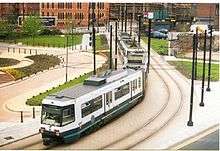 A pair of coupled T-68s near Piccadilly station in 1994.
A pair of coupled T-68s near Piccadilly station in 1994. T-68A tram no. 2004 in Eccles, in 2005.
T-68A tram no. 2004 in Eccles, in 2005.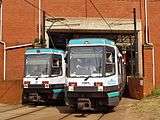 Two T68s at the entrance to Victoria station in 2008.
Two T68s at the entrance to Victoria station in 2008..jpg) Driving position of T-68 tram.
Driving position of T-68 tram.- Original Metrolink tram and First Manchester Scania OmniCity Articulated bus in Manchester city centre, 2011.
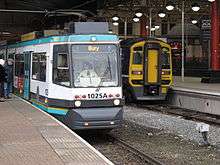
Media
In December 2010, a T-68 was used in the 50th anniversary live episode of the television programme Coronation Street, of the show to portray a tram crash on the street. As well as a mock-up tram for scenes after the crash, real life T-68 1015 was also used, given the nonexistent fleet number 1030 and temporarily vinyl wrapped in the new livery.[18]
References
- 1 2 3 4 5 "T68 and T68a — Metrolink phase 1 and 2". LRTA. Retrieved 15 December 2016.
- 1 2 3 4 "Metrolink Trams". TheTrams.co.uk. Retrieved 8 June 2008.
- ↑ "Historic day as Metrolink tram enthusiasts make final trip on the T68". Manchester Evening News. 26 May 2014. Retrieved 31 May 2014.
- 1 2 "Manchester Metrolink, United Kingdom". railway-technology.com. Retrieved 10 January 2013.
- 1 2 3 "Manchester Metrolink 1007". Heaton Park Tramway. Retrieved 15 December 2016.
- 1 2 3 Manchester Metrolink British Trams Online
- ↑ https://www.flickr.com/photos/dwbphotos/5550473128/
- ↑ https://www.flickr.com/photos/47118s-pixs/6825235959/
- ↑ End of the line for Metrolink's first tram fleet Manchester Evening News 30 April 2014
- ↑ "Manchester Metrolink to order 20 new trams". Railway Technology. Retrieved 16 December 2016.
- ↑ Special charity event will bid farewell to T68s Archived 21 August 2014 at the Wayback Machine. Transport for Greater Manchester 14 May 2014
- ↑ Manchester Metrolink 1007 Heaton Park Tramway
- ↑ http://www.britishtramsonline.co.uk/news/?p=11016
- ↑ "UK moves to create tram test fleet" Tramways & Urban Transit issue 921 September 2014 page 360
- ↑ "Four Metrolink T68s moved to Long Marston". RAIL (758): 25. 1 October 2014. ISSN 0953-4563.
- ↑ "Vehicle Collection". Museum of Transport Greater Manchester. Retrieved 15 December 2016.
- ↑ A taste of things to come, in Manchester, Geograph.org
- ↑ "Coronation Street Tram Crash 6th December 2010 - Tram 1015 Burma Star (Marked up as tram 1030 on the show)". Flickr. Retrieved 20 September 2011.
External links
![]()

